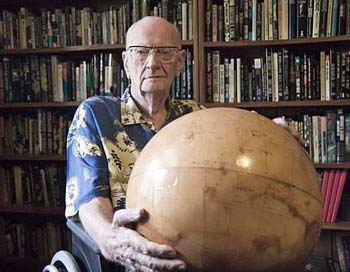The death of the famous science fiction writer Arthur C. Clarke was accompanied by a cosmic fireworks display of gamma rays, the same bursts of energy that he feared
About eight years ago, in an interview with the BBC, the famous science fiction writer Arthur C. Clark defined what he believed to be the four greatest threats to the future of the human race: "Global warming, environmental pollution, an asteroid impact on the Earth and a burst of gamma rays." On March 19, 2008, Clarke passed away after completing just over 90 orbits around the sun.

Science fiction writer Arthur C. Clarke was a physicist, mathematician and engineer. He became known for his ability to predict technological developments such as the Internet and the cell phone and is considered the father of the idea of communication satellites. The strip of geostationary communication satellites circling the equator in space is called Clark's strip after him. Among his well-known books are "The End of Childhood" and "2001 Space Odyssey", which was adapted into a film by Stanley Kubrick.
The universe, in a fortuitous gesture (since Clark strongly rejected any mystical explanation), that night emitted the most powerful gamma-ray burst ever recorded, the accompanying glow of which could be seen even without a telescope. Lucky that the event happened half a universe away from here. If it had happened closer "we would have been lost," as Clark said in the same interview. "I think this phenomenon may have affected evolution, and if it happens again, we won't be able to do anything."
The threat of global warming is known and recognized, and awareness of it is increasing, but what are gamma ray bursts anyway? Most of these bursts of radiation occur when very massive stars use up their supply of nuclear fuel. When the nuclear processes are over, the cores of the stars collapse and form black holes or neutron stars. During the collapse, an intense burst of gamma radiation is released with enormous energy and a jet of particles is splashed into space at a speed close to the speed of light. When a jet passes through clouds of interstellar matter it heats the gas to a temperature of several thousand degrees. At these temperatures the gas glows and you can see the glow even in visible light. This flash of light could be seen on Earth on the night of March 19, when Clark died.
The flash was first captured by the Swift satellite of the American space agency, NASA, and it broke the record for the most distant object that can be seen with the unaided eye. "It was tremendous," says Neil Gehrles, the satellite's principal investigator, "it was far beyond any burst of gamma radiation we've detected to date." After Swift located the explosion in the constellation "The Bear Shepherd", telescopes all over the world were quickly directed to it, including the telescope called "The Very Large Telescope" in Chile. According to precise measurements of the light frequency shift, it was determined that the event that created the burst occurred at a distance of 7.5 billion light years, that is, 7.5 billion years ago at a time when the universe was less than it is today and the Earth had not yet formed. This is a distance of more than half of the visible universe. The flash of light was 2.5 million times more powerful than any supernova ever recorded, meaning it is the most luminous object observed by humans in the universe. It is the huge distance that prevented any damage on Earth as a result of the intense radiation. A similar burst, if it had occurred close to Earth, would have fulfilled all of Clark's fears in its destruction.

The glow of light following the gamma ray burst is seen here as a flash of light between the stars. It may not be impressive, but it must be remembered that this is a light that set out billions of years before the earth was even formed.
The work of analyzing the data has only just begun, so there is still no explanation as to why the burst of radiation was so intense. This May, NASA plans to launch the Large Area Gamma-ray Space Telescope, GLAST, to study exotic environments, such as the regions near black holes and very massive neutron stars that produce enormous power in the form of high-energy gamma rays. This burst was delayed by the new satellite to explore.
The intense radiation burst, designated GRB 080319B, was one of four gamma-ray bursts detected by the Swift satellite on March 19 – a record number in one day. The satellite's research team member, Judith Rakusin, concluded by saying: "By chance, the death of Arthur C. Clarke seems to have ignited the universe with a show of gamma-ray bursts." A fitting farewell by all accounts.

7 תגובות
Larnon
About this it is said (here):……….
"You need to know on which side of the universe to be born"
A summary of Arnon's words:
"that we don't know"
A short notice on Earth, complete destruction of some life forms at the other end of the universe?
Stunning
How much beauty, how much wisdom and how much knowledge in physics, acquired over generations of research, fit into such a short piece of information. Thanks.
What is happening here is very romantic...